The R/V Thomas G. Thompson left Honolulu on November 5, 2011 heading toward the Western Pacific. This expedition journal was written by cruise participants and uploaded about once per weekday, depending on internet availability.
December 5, 2011: Masako (雅子) Tominaga: The Chief of Science
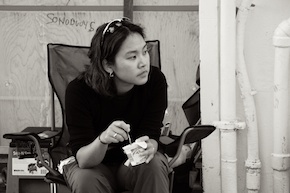
Breakfast on deck (Credit: Will Koeppen)
When you hear the words “chief scientist”, what do you think of? A person who manages every minute detail of the scientific operations, a stressed-out decision maker, an aloof senior scientist? None of these conceptions about Masako Tominaga, our chief scientist, are correct. This is the story of who the chief scientist is, and how she came to the position that she now holds on our cruise.
This is Masako’s first cruise as chief scientist, and I asked her what the job entails. Her responsibilities began long before she ever set foot on the ship. Nine years ago she became involved in the long term effort to investigate the nature of the Jurassic Quiet Zone, research led by H. Paul Johnson, Will Sager, and Maurice Tivey. Along with Maurice, Will, Dan Lizarralde, and Adrienne Oakley, she formulated a collaborative research proposal to continue their work in 2011. A research proposal is a detailed plan that includes specifics about scientific goals, expected outcomes, how the research benefits the broader community, instrument technology, and data acquisition. It also includes a complete budget with justifications for all costs and a cruise plan that makes the best use of everyone's resources. In writing the proposal, they had take into account all past research in the Jurassic Quiet Zone and prove that the cruise would add to knowledge about the area and not repeat any previous work.
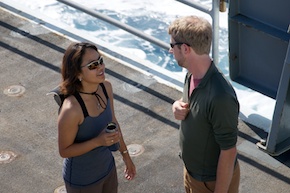
Sentry-speak with James (Credit: Will Koeppen)
Once the proposal was funded, the real fun began. Masako and her collaborators were responsible for dealing with all of the logistics that go into shipboard oceanographic research. For this cruise, that included securing 42 days of ship-time, coordinating with technicians on both coasts, recruiting all of the scientists and students needed on board, and organizing travel for people and equipment, among other things.
Now that she’s on the ship, I asked Masako what it is like to be in charge of day-to-day science operations. She replied by saying that each chief scientist has their own style of leadership. In her case, successful planning that lays a strong foundation for a successful cruise is the first part. The second is to be an observer rather than a micromanager while on board. Masako enjoys choosing her role on the ship and wants to see everyone else involved in the research based on their interests and abilities. Third, she said she commits herself to maximize scientific outcome even when things do not go according to plan.
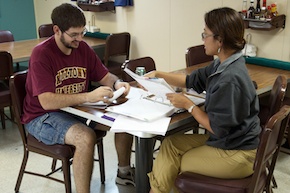
Interviewee (Credit: Will Koeppen)
To an outsider it may seem like being a chief scientist is a stressful job, but Masako says that she isn't stressed at all. She says that if the leadership becomes stressed and worried, the feelings can infect everyone else. Instead, she tries to be everyone’s “cheerleader,” making sure that each of us feels appreciated. She said it also helps to have complete trust in the captain, crew, and science team. According to Masako, her favorite part of being the chief scientist is that she can tell if she is doing a good job from the immediate response of others onboard. This feedback makes the position a great opportunity to grow both personally and professionally. Her least favorite part is that she finds it difficult to have private moments and mentally detach from her many responsibilities. Even during her few moments of free time, when trying to relax outside on deck, she is constantly thinking about her work.
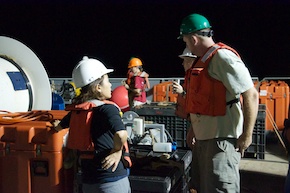
Talking seismics with Lee (Credit: Will Koeppen)
I wanted to know a little more about our chief scientist's background. What makes a Masako? She comes from Kamakura, an ocean-side town in Japan, where she grew up watching waves. Masako always loved critical thinking and numbers and she decided to go to school for engineering. She graduated from Waseda University in Tokyo with a bachelor’s degree in petroleum engineering and drilling, working on projects related to borehole stability in oil fields. However, at that time she felt that women in advanced careers were under-appreciated in Japan, and she wanted to pursue her own research interests. Masako came to the United States ten years ago and, because of her love of physics and the ocean, entered a marine geophysics program at Texas A&M. After obtaining her Master’s and PhD in geological oceanography, she was employed as a research associate there for four months before going to WHOI for eighteen months as a post-doctoral scholar. It was while she was at WHOI that she worked with Maurice, Will, Dan, and Adrienne to compile the proposal for this research.
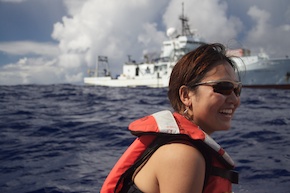
Still enjoying it (Credit: Will Koeppen)
At the end of the cruise on December 17th, 2011, Masako will have logged 449 days at sea on 11 cruises in the past 10 years, 5 of which were scientific drilling expeditions. When I asked her which cruise was her favorite, Masako named ours (so far). She said she appreciates our good team of respectful and mature people that can perform their duties while still having fun. She also cited the mentorship and support that she receives from her collaborators. From my perspective, this cruise also has a great chief scientist who enables the entire science team to work together. In her words, “a happy cruise makes for good science.” ♦
